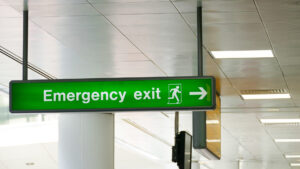
It is critical to minimize fire risks in a commercial building because these steps help to protect both people and property.
Fire hazards pose significant risks to commercial buildings, jeopardizing the safety of occupants, potentially damaging property, and disrupting business operations. However, by implementing effective preventative measures, businesses can significantly reduce the likelihood of a fire and mitigate potential losses while avoiding code violations.
Install and Maintain Fire Detection Systems
The first line of defense against fires is a robust fire detection system. Commercial buildings should be equipped with smoke detectors, fire alarms, and sprinkler systems. Which systems you have will depend on the type of facility you’re running. Make sure your systems are adequate for your needs—and remember, more protection is always better.
Regular maintenance and inspections of these systems are crucial to ensure they are operable and code compliant. Fire detection systems should be integrated with central monitoring stations to provide a prompt response in case of an emergency.
Implement Fire Safety Training
Employees should receive comprehensive fire safety training to familiarize themselves with evacuation procedures, systems operations, the proper use of fire extinguishers, and the importance of reporting fire hazards. Regular drills and simulations can help reinforce safety protocols and ensure everyone knows how to respond swiftly and calmly in the event of a fire.
Establish Clear Emergency Exit Routes
Commercial buildings must have well-defined emergency exit routes that are clearly marked and easily accessible. Exit signs should be visible from various angles and locations within the building. Regular inspections should be conducted to ensure exit routes are unobstructed and free from any potential hazards.
Maintain Electrical Systems
Electrical malfunctions are a common cause of fires in commercial buildings. Regular inspection and maintenance of electrical systems, including wiring, circuit breakers, and outlets, are essential to prevent overheating and short circuits. Any signs of faulty wiring or other electrical issues should be addressed promptly by a certified electrician.
Control Potential Ignition Sources
Identifying and controlling potential ignition sources is critical in reducing fire risks. This includes ensuring proper storage and handling of combustible and flammable materials, such as chemicals and fuels. Smoking should be prohibited outside of designated areas, and designated smoking zones should have appropriate fire-resistant disposal units. Heating equipment, such as furnaces or space heaters, should be regularly inspected and maintained.
Enhance Structural Fire Protection
Commercial buildings should be constructed or retrofitted with fire-resistant materials to minimize fire spread and structural damage. Fire-rated doors, walls, and ceilings can help compartmentalize the building, restricting the movement of flames and smoke. Fireproof insulation and fire stops should be installed in wall cavities and floor penetrations to prevent fire from spreading through concealed spaces.
Regular Inspections and Maintenance
Routine inspections and maintenance procedures are crucial to identifying potential fire hazards and addressing them promptly. This includes checking fire extinguishers, emergency lighting systems, HVAC systems, and other fire safety equipment. Regular inspections should also be conducted on fire exits, fire doors, and fire-resistant barriers to ensure they meet safety standards.
Fire Protection Services from Fireline
Whether you need smoke detectors, fire extinguishers, or an automatic sprinkler system installed at your commercial property, Fireline has you covered. We have been protecting
people and property from fire damage since 1947—and our experience shows in our excellent work! We are known for our superb customer service, our expertise, and our reliability. For more information on how we can help your residential or commercial property, visit us online or give us a call at (800) 553-3405. We are in Baltimore, MD, with a second office in Leesburg, VA. For more fire safety tips, be sure to follow us on Facebook, Twitter, and LinkedIn.
